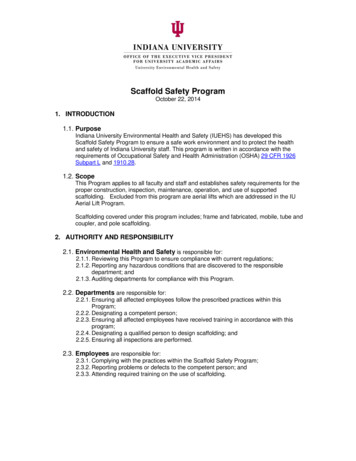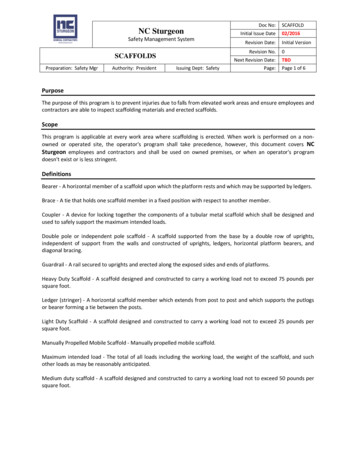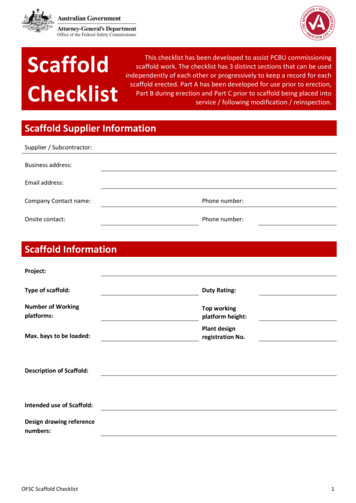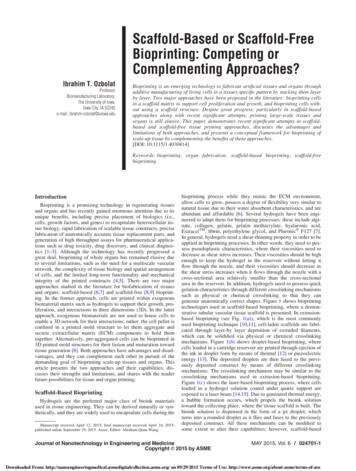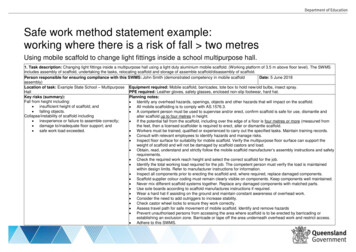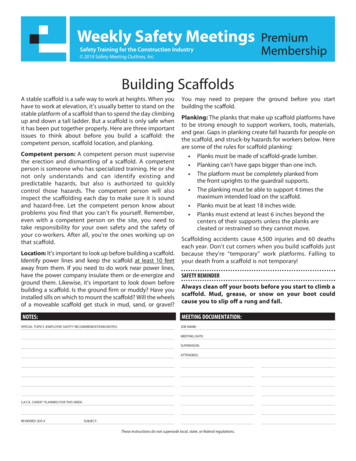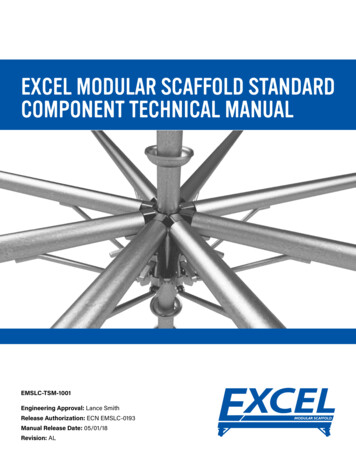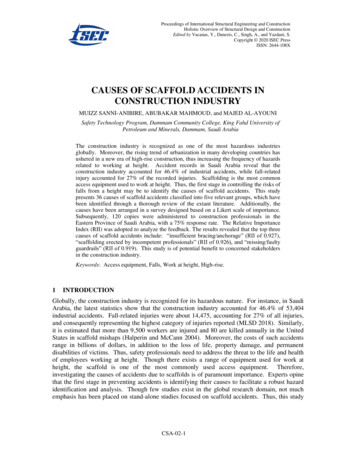
Transcription
Proceedings of International Structural Engineering and ConstructionHolistic Overview of Structural Design and ConstructionEdited by Vacanas, Y., Danezis, C., Singh, A., and Yazdani, S.Copyright 2020 ISEC PressISSN: 2644-108XCAUSES OF SCAFFOLD ACCIDENTS INCONSTRUCTION INDUSTRYMUIZZ SANNI-ANIBIRE, ABUBAKAR MAHMOUD, and MAJED AL-AYOUNISafety Technology Program, Dammam Community College, King Fahd University ofPetroleum and Minerals, Dammam, Saudi ArabiaThe construction industry is recognized as one of the most hazardous industriesglobally. Moreover, the rising trend of urbanization in many developing countries hasushered in a new era of high-rise construction, thus increasing the frequency of hazardsrelated to working at height. Accident records in Saudi Arabia reveal that theconstruction industry accounted for 46.4% of industrial accidents, while fall-relatedinjury accounted for 27% of the recorded injuries. Scaffolding is the most commonaccess equipment used to work at height. Thus, the first stage in controlling the risks offalls from a height may be to identify the causes of scaffold accidents. This studypresents 36 causes of scaffold accidents classified into five relevant groups, which havebeen identified through a thorough review of the extant literature. Additionally, thecauses have been arranged in a survey designed based on a Likert scale of importance.Subsequently, 120 copies were administered to construction professionals in theEastern Province of Saudi Arabia, with a 75% response rate. The Relative ImportanceIndex (RII) was adopted to analyze the feedback. The results revealed that the top threecauses of scaffold accidents include: “insufficient bracing/anchorage” (RII of 0.927),“scaffolding erected by incompetent professionals” (RII of 0.926), and “missing/faultyguardrails” (RII of 0.919). This study is of potential benefit to concerned stakeholdersin the construction industry.Keywords: Access equipment, Falls, Work at height, High-rise.1INTRODUCTIONGlobally, the construction industry is recognized for its hazardous nature. For instance, in SaudiArabia, the latest statistics show that the construction industry accounted for 46.4% of 53,404industrial accidents. Fall-related injuries were about 14,475, accounting for 27% of all injuries,and consequently representing the highest category of injuries reported (MLSD 2018). Similarly,it is estimated that more than 9,500 workers are injured and 80 are killed annually in the UnitedStates in scaffold mishaps (Halperin and McCann 2004). Moreover, the costs of such accidentsrange in billions of dollars, in addition to the loss of life, property damage, and permanentdisabilities of victims. Thus, safety professionals need to address the threat to the life and healthof employees working at height. Though there exists a range of equipment used for work atheight, the scaffold is one of the most commonly used access equipment. Therefore,investigating the causes of accidents due to scaffolds is of paramount importance. Experts opinethat the first stage in preventing accidents is identifying their causes to facilitate a robust hazardidentification and analysis. Though few studies exist in the global research domain, not muchemphasis has been placed on stand-alone studies focused on scaffold accidents. Thus, this studyCSA-02-1
Vacanas, Y., Danezis, C., Singh, A., and Yazdani, S. (eds.)aims at investigating the causes of scaffold accidents in the Saudi Arabian construction industry,with the Eastern Province taken as a regional case study.2LITERATURE REVIEWAn accident may be described as an unwanted and unexpected event, which may result fromnumerous causes. The first step in accident prevention is to understand the root causes ofaccidents. To this end, models have been developed, such as domino’s theory by Heinrich in1930 and multiple causation theory by Petersen in 1971 (Hamid et al. 2008). Falls from heightare considered amongst the most common types of construction accidents. A fall can be definedas a downward movement due to a worker’s loss of balance. There are numerous causes of fallhazards, including unsafe act, unsafe working condition, communication problems andmanagement’s commitment (Liy et al. 2016). The scaffold is an essential equipment for work atheight in the construction industry. Generally, a scaffold is a temporary structure to facilitatework at height while ensuring its users’ safety. The erection of scaffolds is based on codes andguidelines, which may vary across different construction industries. In the UK, the “BS 5973(1993) Code of Practice for Access and Working Scaffolds and Special Scaffolds in Steel” isapplicable, while in the USA, the “Code of Federal Regulations 29 CFR, Part 1926, Subpart L”provided by OSHA is applicable (Reese and Eidson 2006). In Saudi Arabia, local organizationshave developed handbooks. This may include Saudi Aramco’s “General Instruction (GI): GI8.001, Safety Requirements for Scaffolds” (Aramco 2016), as well as the “Scaffolding Activitiesand Responsibilities Requirements” developed by the Saudi Standards, Metrology and QualityOrganization (SASO 2017). Despite the existence of standards, accidents reported in work atheight vis-à-vis scaffolds are still high, and thus understanding the causes of scaffold accidentsmay help to ultimately control the risk of scaffold accidents. Few studies exist which discuss thecauses of scaffold accidents in various construction climates globally.Whitaker et al. (2003) presented a study that developed a decision aid to promote scaffoldsafety. The authors reviewed 186 paper-based files and 2,910 computer-based files of accessrelated incidents in the UK. The study suggested that the most frequent causes of scaffoldaccidents include: “the fitting of defective components”, “unauthorized modification of thestructure”, “omission of barriers”, and “errors resulting in simple, readily detectable structuralfaults”; while common managerial deficiencies included “failure to control risk”, “unsafemethods and procedures”, and “inadequate training and supervision”. Halperin and McCann(2004) developed a 150-point checklist to assess the safety practices at 113 scaffolds in nine areasof eastern United States. The study concluded that thirty-six scaffolds (31.9%) were either indanger of collapse or were missing planking, guardrails, or adequate access. It also suggested astrong correlation between structural flaws and fall protection hazards, as well as betweenscaffold safety practices and competent/trained scaffold personnel. A more direct study toinvestigate the causes of scaffold accidents was presented by Enshassi and Shakalaih (2015) inthe Gaza Strip. The study identified 33 causes of scaffold accidents categorized into six groups.The results of 35 received questionnaire surveys showed that the top-most causes were: theabsence of personal protective equipment (PPE), missing ladders, and wind loads. A study byBłazik-Borowa and Szer (2015) suggested that the most common causes of accidents in scaffoldscould be related to violation of regulations, economic factors, and lack of knowledge of issuessuch as loads, assessment of the technical state and construction-capacity for multiple uses etc.Liy et al. (2016) investigated the causes of fall accidents in Kuching, Malaysia. The studyshowed that falls from roofs and scaffolds are the most significant areas of fall hazards. The mainCSA-02-2
Proceedings of International Structural Engineering and ConstructionHolistic Overview of Structural Design and Constructioncause identified in the study was related to communication barriers, workers’ negligence, lack ofsafety devices, poor site management, lack of PPEs.3METHODOLOGY3.1 Stage 1: Review of the Extant LiteratureAn extensive literature review to identify the causes of scaffold accidents was carried out. Aninitial list of 52 causes was made, which was further refined into 32 causes based on discussionswith three construction professionals. This also involved reviewing a draft questionnaire surveyto ensure clarity, inclusiveness, and avoidance of redundancy.3.2 Stage 2: Questionnaire Administration and AnalysisThe questionnaire was administered to construction site supervisors and project managers in theEastern Province of Saudi Arabia. The questionnaire entailed demographic information of therespondents and contained 36 causes of scaffold accidents in five categories, as shown in Table 1.The respondents were required to rate the importance of each factor on a 5-point Likert scale asfollows: 1 “not important”, 2 “little importance”, 3 “somewhat important”, 4 “important” and 5“very important”. Results were analyzed using the RII approach presented by Holt (2014). Atotal of 120 questionnaires were either distributed in person or sent by emails, with an initialfeedback of 93 responses, and usable feedback of 90 responses representing a 75% response rate.4RESULTS AND DISCUSSIONThe demographic results showed that the highest group of all respondents (26.7%) had 5 to 10years of experience, 14.2% had less than 5 years of experience, 19.6% had 10 to 15 years ofexperience, while 19.6% had more than 15 years of experience. The results also showed that33% of the respondents were experienced in commercial projects, 30% in residential projects,29% in industrial projects, and 8% in highway projects. The RII values computed from theresults are presented in Table 1 according to five categories and are thus systematically discussed.4.1 Scaffold Erection ComponentsThe results showed that “insufficient bracing/anchorage to prevent the movement of scaffolds”was ranked highest with RII of 0.927. This factor is related to the structural stability of thescaffold (Enshassi and Shakalaih 2015). It can also be inferred that scaffold erection bycompetent persons, or specially trained crews is crucial to ensuring its stability. “Lack of/orfaulty guardrails for each platform to protect workers from falls” was ranked second with RII of0.919. This result is similar to Heckmann (1995), who concluded that “guardrail requirements” isthe most important factor contributing to falling accidents from scaffolds. “Damaged or faultyscaffold tubes” was ranked third with RII of 0.900. “Incompatibility of scaffolding components(due to being manufactured from more than one source)” was ranked last with RII of 0.769.4.2 Unsafe ActThis group comprised of eight causes. The findings revealed that “overloading of the scaffolding(workers and materials)” was ranked first with RII of 0.918. “Failure to use personal protectiveequipment (PPE) (e.g., hard hats, fall protection system)” was ranked second with RII of 0.913.Similarly, Enshassi and Shakalaih (2015) concluded that failure to use PPE by workers is themost important cause of scaffold accidents. “Borrowing (removal of scaffold components whileCSA-02-3
Vacanas, Y., Danezis, C., Singh, A., and Yazdani, S. (eds.)in use)” was ranked third with RII of 0.902. This emphasizes the need to ensure that such crucialelements such as braces, standards, or ladders remain in place while the scaffold is in use.Table 1. RII values for the causes of scaffold accident according to various 252627282930313233343536Causes related to Scaffold Erection ComponentsRIIInsufficient bracing/anchorage to prevent the movement of scaffolds.Lack of/or faulty guardrails for each platform to protect workers from falls.Damaged or faulty scaffold tubes.Ladders are not used or installed for movement between the platforms.Scaffolding components are not inspected prior to erection.Scaffolding is not tied to the building (independent tied or putlog).Inadequate number of ties in the erection of planks.Insufficient width of scaffolding platforms for the movement of workers.Lack of/inadequate toe boards.Incompatibility of scaffolding components (due to being manufactured frommore than one source).AverageCauses related to Unsafe ActOverloading of the scaffolding (workers and materials).Failure to use personal protective equipment (e.g. hard hats, fall protectionsystem).Borrowing (removal of scaffold components while in use)Workers moving between the platforms by jumping and they do not use accessequipment (e.g. ladders).Fatigue, stress and illness of workers on the scaffolding.Improper use of tools/safety equipment.Not using appropriate jacks to lift up materials and tools.Improper positioning and posture during working.AverageCauses related to Unsafe ConditionPoor ground conditions (weak and uneven base).Potential contact with electrical wire/cables/connections.Vehicle collision with the scaffolding.Bad weather (rainy/windy/severe heat).Lack of safety net/shrouds not properly installed to prevent the fall of objects.Inadequate passages and paths due to working in crowded spaces.Poor site housekeeping.AverageCauses related to Communication BarriersLanguage barrierPoor communication lines among safety officers and employeesLack of/unclear signage and warning signsUnclear instructions/poor informationAverageCauses related to Management and OrganizationScaffolding is erected by incompetent/untrained/uncertified contractors.Failure to provide appropriate/sufficient PPE.Lack of workers training.Lack of frequent inspection by competent persons.Lack of safety policies.Lack of compliance to code requirements.Inadequate planning during the preconstruction 00.8760.8680.8380.8841234567
Proceedings of International Structural Engineering and ConstructionHolistic Overview of Structural Design and Construction4.3 Unsafe ConditionThe results revealed that “poor ground conditions (weak and uneven base)” was ranked first withRII of 0.915. This factor shows the importance of the scaffold’s foundation as suggested byWhitaker et al. (2003). “Potential contact with electrical wire/cables/connections” was rankedsecond with RII of 0.891. “Vehicle collision with the scaffolding” was ranked third with RII of0.881, highlighting the need for adequate barriers between scaffolds and the movement of peopleand equipment in construction sites.4.4 Communication BarriersThe causes related to communication barriers were perceived in decreasing order by therespondents as follows: “language barrier” with RII of 0.849; “poor communication lines amongsafety officers and employees” with RII of 0.831; and “lack of/unclear signage and warningsigns” with RII of 0.800. Communication barriers may be attributed to the different languages offoreign workers commonplace in the Middle East. Thus, there is a potential problem due to poorline of communication between the management and workers, as well as between workers.4.5 Management and OrganizationThe results showed that “scaffold is erected by incompetent/untrained/uncertified contractors”was ranked first with RII of 0.927. Trained scaffold erection crews are likely to erect saferscaffolds (Halperin and McCann 2004). “Failure to provide appropriate/sufficient PPE” wasranked second with RII of 0.899. Previous studies have shown that lack of safety training as wellas inadequate provision of PPE had increased the risk of falls. Furthermore, loose traditionalclothing common amongst construction workers in Middle Eastern countries may contribute tothe risk of falls. The average RII results summarized in Figure 1 also show that the mostimportant cause is the Management and Organization group with RII of 0.884. It is thus criticalthat management’s commitment to safety be emphasized due to its being crucial to preventingaccidents.Figure 1. Plot of averaged RII values for grouped causes of scaffold accidents.CSA-02-5
Vacanas, Y., Danezis, C., Singh, A., and Yazdani, S. (eds.)5CONCLUSIONSThis study has presented an investigation of the causes of scaffold accidents in the Saudi Arabianconstruction industry. Its significance is based on historical reports, which suggest that scaffoldaccidents constitute the majority of workplace accidents in Saudi Arabia. Based on the resultspresented in previous sections, it can be concluded that poor design, erection, and maintenance ofscaffolds, as well as inadequately trained/incompetent professionals, were the root causes ofscaffold accidents in Saudi Arabia. Hence, safer scaffolds could be achieved through ensuring: The implementation of scaffold safety practices through inspecting and monitoring ofconstruction sites. Competent persons are responsible for scaffold erection, dismantling through training oroutsourcing to qualified and certified contractors. Adequate provision and correct use of PPEs and fall arrest systems. Competent persons are available for supervision and monitoring during work at height withthe scaffold.AcknowledgementsThe authors thank King Fahd University of Petroleum and Minerals for the support and facilities that madethis research possible.ReferencesAramco, General Instruction (GI): GI 8.001, Safety Requirements for Scaffolds, Loss PreventionDepartment, Saudi Arabian Oil Company, Dhahran, Saudi Arabia, 2016.Błazik-Borowa, E., and Szer, J., The Analysis of the Stages of Scaffolding “Life” With Regard to TheDecrease in The Hazard at Building Works, Archives of Civil and Mechanical Engineering, 15(2),516-524, February, 2015.BS 5973, Code of Practice for Access and Working Scaffolds and Special Scaffolds in Steel, BritishStandards Institute (BSI), London, UK, 1993.Enshassi, A., and Shakalaih, S., Construction Workers Fall Accidents from Scaffolding in Gaza Strip,In The 6th International Conference on Construction Engineering and Project Management (ICCEPM2015). 2015.Halperin, K. M., and McCann, M., An Evaluation of Scaffold Safety at Construction Sites, Journal of SafetyResearch, 35(2), 141-150, 2004.Hamid, A. R. A., Majid, M. Z. A., and Singh, B., Causes of Accidents at Construction Sites, MalaysianJournal of Civil Engineering, 20(2), 2008.Heckmann Jr, J. V., Analysis of Accidents Related to Scaffolding and Floor/Wall Openings, WashingtonUniv St Louis Mo Dept of Civil Engineering, 1995.Liy, C. H., Ibrahim, S. H., Affandi, R., Rosli, N. A., and Nawi, M. N. M., Causes of Fall Hazards inConstruction Site Management, International Review of Management and Marketing, 6(8S), 257-263,2016.MLSD, Ministry of Labour and Social Development, Statistical Work Injury in the Kingdom of SaudiArabia, 2018.Reese, C. D., and Eidson, J. V., Handbook of OSHA Construction Safety and Health, CRC Press, 2006.SASO, Saudi Standards, Metrology and Quality Organization, Scaffolding Activities and ResponsibilitiesRequirements, 2017.Whitaker, S. M., Graves, R. J., James, M., and McCann, P., Safety with Access Scaffolds: Development ofA Prototype Decision Aid Based On Accident Analysis, Journal of Safety Research, 34(3), 249-261,August, 2003.CSA-02-6
RII values for the causes of scaffold accident according to various categories. Causes related to Scaffold Erection Components RII In-Group Ranking 1 Insufficient bracing/anchorage to prevent the movement of scaffolds. 0.927 1 2 Lack of/or faulty guardrails for each platform to protect workers from falls. 0.919 2 3 Damaged or faulty scaffold .
